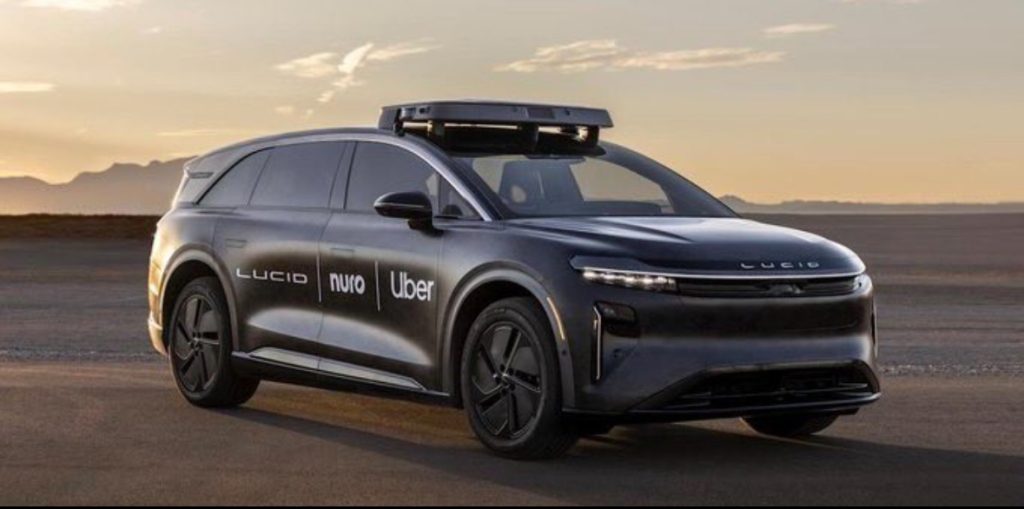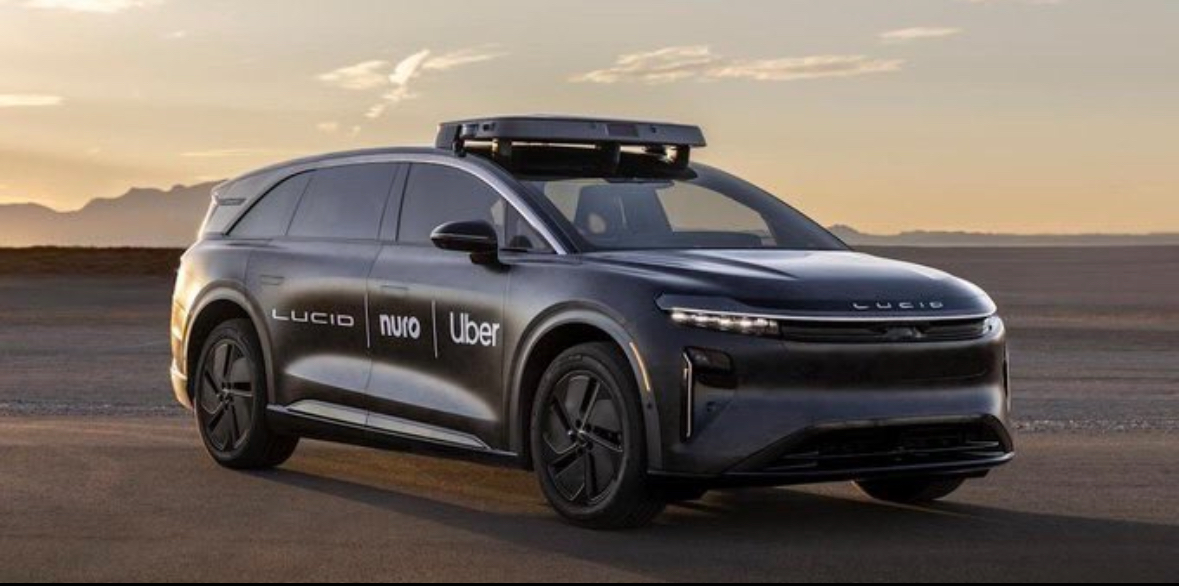
In a transformative development for the autonomous vehicle industry, Lucid Group, Inc. (NASDAQ: LCID) saw its stock price soar by nearly 30% on July 17, 2025, closing at $3.60, following a landmark $300 million investment from Uber Technologies, Inc. (NYSE: UBER). The investment is part of a strategic partnership with Lucid and autonomous vehicle technology startup Nuro to deploy a fleet of over 20,000 Lucid Gravity SUVs as premium robotaxis on Uber’s platform, starting in 2026. Notably, Uber’s decision to partner with Lucid over industry giant Tesla, Inc. (NASDAQ: TSLA) signals a bold shift in the competitive landscape of the burgeoning robotaxi market.
A Game-Changing Partnership
Announced on July 17, 2025, the collaboration between Uber, Lucid, and Nuro aims to launch a “next-generation premium global robotaxi program” that integrates Lucid’s advanced electric vehicle (EV) technology, Nuro’s Level 4 autonomous driving software, and Uber’s expansive ride-hailing network. The program is set to debut in a major U.S. city in late 2026, with plans to scale to dozens of markets worldwide over the next six years. Uber’s commitment to purchase and deploy at least 20,000 Lucid Gravity SUVs, which boast an industry-leading 450-mile EPA estimated range, underscores the partnership’s ambition to redefine urban mobility with high-efficiency, autonomous ride-hailing services.
The Lucid Gravity, a premium electric SUV, is uniquely suited for this venture due to its advanced software-defined vehicle architecture, redundant electrical systems, and spacious interior, which align perfectly with the demands of a scalable robotaxi service. Nuro’s Level 4 autonomy system, known as the Nuro Driver™, combines cutting-edge AI with automotive-grade hardware to enable driverless operation in specific conditions without human intervention. Uber’s global platform, which facilitates an average of 34 million trips daily across 70 countries, provides the scale necessary to make this service accessible and economically viable.
Uber’s Strategic Pivot and Investment
Uber’s $300 million investment in Lucid, alongside a separate multi-hundred-million-dollar investment in Nuro, marks a significant reentry into the autonomous vehicle space. After exiting its in-house autonomous vehicle division in 2020 following a fatal accident in 2018, Uber has shifted to a partnership-driven model, collaborating with companies like Waymo, Volkswagen, and now Lucid and Nuro to bolster its robotaxi offerings. This approach allows Uber to leverage external expertise while avoiding the high costs and regulatory challenges of developing autonomous technology in-house.
The investment has positioned Uber as Lucid’s second-largest shareholder, trailing only Saudi Arabia’s Public Investment Fund, which holds a $4.29 billion stake in the EV maker. The financial backing will support Lucid’s efforts to scale production, particularly for the Gravity SUV, which recently entered showrooms after a strong second quarter of deliveries in 2025. Lucid aims to deliver 20,000 vehicles, including its Air sedan and Gravity SUV, this year, and the Uber order is expected to significantly contribute to meeting this target.
Why Lucid Over Tesla?
Uber’s decision to choose Lucid over Tesla, a pioneer in autonomous driving technology, has raised eyebrows in the industry. Tesla has been aggressively pursuing its robotaxi ambitions, launching a limited pilot program in Austin, Texas, in June 2025 with a small fleet of Model Y SUVs equipped with its Full Self-Driving (FSD) software. However, Tesla’s FSD system, classified as Level 2 autonomy, still requires human supervision, and its robotaxi trials have faced challenges, including reports of phantom braking and regulatory scrutiny. In contrast, Nuro’s Level 4 technology, already tested in autonomous delivery operations, offers a more advanced and reliable solution for driverless ride-hailing.
Lucid’s Gravity SUV also provides a competitive edge with its 450-mile range, which minimizes downtime for charging and enhances operational efficiency—a critical factor for robotaxi economics. Tesla’s Model Y, while popular, offers a shorter range, potentially leading to more frequent charging and reduced vehicle availability. Additionally, Lucid’s premium design and spacious interiors align with Uber’s strategy to position this service as a high-end offering, akin to its Uber Black tier.
Market Reaction and Competitive Landscape
The market’s response to the announcement was swift, with Lucid’s stock surging as much as 56% in pre-market trading on July 17, reflecting investor confidence in the company’s expanded role in the autonomous vehicle market. However, Lucid also announced a proposed one-for-ten reverse stock split, which may help stabilize its share price after a 24% year-to-date decline prior to the deal. Despite the rally, analysts remain cautious, with a consensus Hold rating and a price target of $2.70, implying a potential 13.88% downside from the July 17 closing price.
The partnership intensifies competition in the robotaxi sector, where Alphabet’s Waymo currently leads with approximately 1,500 vehicles operating in multiple U.S. cities and over 100 million miles of autonomous driving logged. Other players, such as Amazon’s Zoox, are also advancing, with plans for commercial services in Las Vegas. Tesla, meanwhile, is pushing to scale its robotaxi program and plans to introduce its purpose-built Cybercab in 2026. The Uber-Lucid-Nuro collaboration, with its scale and technological synergy, positions it as a formidable challenger in this crowded field.
Implications for Lucid and the EV Industry
For Lucid, a niche player in the EV market with only 3,309 vehicles delivered in Q2 2025, this partnership is a lifeline. The $300 million infusion and the commitment to purchase 20,000 Gravity SUVs provide much-needed financial stability and production volume, helping Lucid compete in a challenging EV market. The deal also validates Lucid’s technological prowess, particularly its redundant zonal architecture, which interim CEO Marc Winterhoff described as “ideal for autonomous vehicles.”
“This investment from Uber further validates Lucid’s fully redundant zonal architecture and highly capable platform as ideal for autonomous vehicles,” Winterhoff said. “This is the start of our path to extend our innovation and technology leadership into this multi-trillion-dollar market.”
Looking Ahead
The Uber-Lucid-Nuro partnership represents a bold bet on the future of autonomous mobility, with significant implications for all three companies. For Uber, it’s a step toward dominating the robotaxi market by leveraging external innovation. For Nuro, it’s a validation of its pivot from delivery bots to licensing Level 4 technology. For Lucid, it’s an opportunity to scale production and establish itself as a key player in both the EV and autonomous vehicle sectors.
As the robotaxi race heats up, the success of this venture will hinge on the seamless integration of Lucid’s hardware, Nuro’s software, and Uber’s operational expertise. With a prototype already operating autonomously at Nuro’s Las Vegas proving grounds, the partnership is off to a promising start. However, regulatory hurdles, safety validations, and competition from established players like Waymo and Tesla will test its resilience. For now, Lucid’s stock surge reflects the market’s optimism, but the road to 2026 will be a critical proving ground for this ambitious collaboration.
